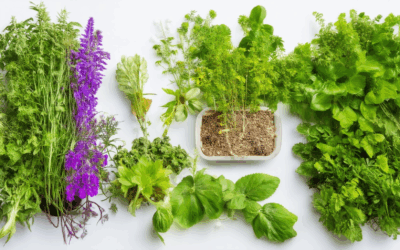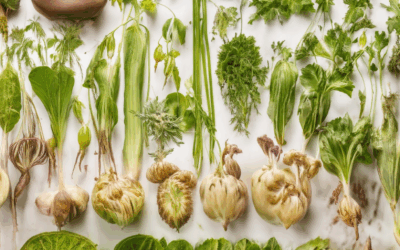Heritage plant cultivation represents a timeless tradition, where the passage of generations has shaped the evolution of plants into unique, often irreplaceable varieties. These heirloom plants, passed down through families for decades, carry with them a rich history and a host of benefits that modern agriculture often overlooks. From preserving rare species to fostering sustainable practices, heritage plant cultivation plays a vital role in protecting biodiversity and ensuring the resilience of our planet. Whether you’re a seasoned gardener or new to the world of botany, understanding the intricacies of heritage plant cultivation can reveal why these plants hold such value in our lives. This article delves into the complexities of what makes a plant an heirloom, the challenges of cultivating rare varieties, and how these heritage plants contribute to a healthier, more sustainable future.
Key Takeaways
– Heirloom Plants Breed True to Type: Ensuring stability and predictability in plant traits over generations.
– Historical and Cultural Significance: Reflecting evolution in agriculture and preserving traditions through generations.
– Genetic Diversity: Providing resilience against pests and environmental changes.
– Unique Traits: Offering distinctive features like color, shape, and flavor, appealing to collectors and enthusiasts.
– Sustainability: Often requiring fewer synthetic inputs, making them eco-friendly choices.
– Flavor and Nutrition: Known for superior taste and nutrient density compared to modern varieties.
– Biodiversity Contribution: Preserving genetic diversity and supporting ecosystem health.
– Challenges: May be harder to source, more costly, and less productive.
– Examples: Tomatoes (“Black Krimm”), Beans (“Painted Mountain”), Peppers (“African Horn”).
– Hybrid vs. Heirloom: Hybrids offer high yield and disease resistance, while heirlooms provide unique flavors and historical value.
– Generational Significance: Can become cherished family possessions over 2-5+ generations, depending on the item.
What Does Heritage Mean in Plants?
Heritage plants, often referred to as heirloom plants, are old cultivars of plants that have been passed down through generations. These plants are cherished for their unique characteristics, historical significance, and ability to thrive under various conditions.
Characteristics of Heritage Plants
- Unique Traits: Heritage plants exhibit distinctive flavors, colors, and textures that modern hybrids often lack. Their diversity arises from years of evolution and adaptation.
- Open-Pollination: Many heritage plants are open-pollinated, meaning they can reproduce naturally without human intervention, allowing for seed preservation and continued growth.
- Diverse History: These plants come from varied backgrounds, each with its own history and cultural importance, contributing to global biodiversity.
Benefits of Heritage Plants
- Cultural Significance: Heritage plants are deeply tied to local cuisines and traditions, helping preserve cultural identities and culinary histories.
- Resilience and Adaptability: Over time, these plants have developed resilience against pests and diseases, making them ideal for organic gardening.
- Sustainable Practices: Their open-pollination nature supports seed preservation, promoting sustainable agriculture and genetic diversity.
Heritage plants are more than just crops; they are a connection to history, a celebration of tradition, and a vital part of a sustainable future. By cultivating these plants, we honor the past while contributing to a healthier, more diverse planet.
What is the Most Difficult Plant to Cultivate?
- Rattlesnake Plant ( Parka rattenhoferi ): Known for its striking arrow-shaped leaves, this plant requires constant attention and high humidity to thrive. Its delicate nature makes it particularly challenging for novice gardeners.
- Monstera ( Monstera deliciosa ): Often called the “Swiss Cheese Plant” due to its distinctive holes, Monstera thrives in damp environments. Its rapid growth can be overwhelming for those unused to managing large plants.
- Coffee Plant ( Camellia sinensis ): While not technically difficult for experienced gardeners, coffee plants require specific soil conditions and regular pruning to produce beans. They can be finicky for those unfamiliar with their care needs.
- Bamboo ( Bambusa ): Although often seen as easy, certain bamboo species are highly invasive and difficult to control once established. Their rapid growth and spreading roots make them a challenge for many gardeners.
Looking for more tips on cultivating these tricky plants? Explore our Growing Guides for expert advice and success stories. At Old Seed, we specialize in helping you grow your greenest future!
Most Expensive Plants to Cultivate
The cultivation of certain plants can be extremely costly due to their rarity, unique care requirements, or high demand in the market. Here is a list of some of the most expensive plants to grow:
- Rose of Jericho – Known as the “resurrection plant,” this rare succulent can fetch thousands of dollars depending on its condition and rarity. (Up to $75,000 per plant)
- Blue Lotus – Often associated with sacredness and luxury, the blue lotus is highly sought after and can cost upwards of $300 per stem. (Up to $300 per stem)
- Golden Torch Cactus – A rare species of cactus, the golden torch can sell for as much as $50,000 due to its striking appearance and limited availability. (Up to $50,000 per plant)
- Ghost Plant – This carnivorous plant, native to the Seychelles, is one of the most expensive orchids, often selling for over $100,000 per specimen. (Up to $100,000 per plant)
- Saintpaulia – Commonly known as the “Star of Madagasca,” this rare pelargonium can command prices over $200 per plant. (Up to $200 per plant)
- Philodendron Birkin – Named after Hermès, this rare plant is one of the most expensive houseplants, with prices reaching up to $500,000. (Up to $500,000 per plant)
- Coffee Plant – While not typically considered a houseplant, the rarest coffee beans can sell for hundreds of thousands of dollars, making the plant itself a valuable commodity. (Up to $250,000 per plant)
- African Violet – One of the most popular and expensive flowering plants, African violets can cost up to $150 per bloom. (Up to $150 per bloom)
- Orchidaceae Family – Many orchids within this family are highly prized, with some species selling for over $1,000 each. (Up to $1,000 per plant)
If you’re interested in exploring these exotic plants further, Old Seed offers a variety of rare and unusual plants that may catch your interest. Check out our collection today!
[Link to Old Seed homepage](https://oldseed.org)
What Makes a Plant an Heirloom Plant?
An heirloom plant is defined as a plant variety that has been passed down through generations of cultivation, typically for at least 50-100 years. These plants are characterized by their ability to “breed true to type,” meaning that their offspring exhibit consistent traits without significant variation. This consistency is crucial for maintaining the integrity of the plant’s characteristics, whether it’s for its appearance, flavor, or other desirable traits.
Key Characteristics of Heirloom Plants:
- Breeding True to Type : Heirloom plants are stable and predictable, producing offspring that closely resemble the parent plant. This trait ensures that the plant’s unique qualities are preserved across generations.
- Historical Significance : Heirloom plants often have historical or cultural value, as they have been nurtured and adapted to specific environments over time. Many heirloom varieties have been around for centuries, reflecting the evolution of agriculture and horticulture.
- Genetic Diversity : Unlike hybrid plants, which may lose genetic diversity due to selective breeding, heirloom plants retain a broader range of genetic material. This diversity can provide resilience against pests and environmental changes.
- Unique Traits : Heirloom plants often exhibit distinctive features such as unusual colors, shapes, or flavors that set them apart from modern varieties. These traits make them sought after by collectors and enthusiasts.
Why Choose Heirloom Plants?
- Sustainability : Heirloom plants are often more resilient and require fewer synthetic inputs, making them eco-friendly choices for gardeners.
- Flavor and Nutrition : Many heirloom crops are known for their superior taste and nutritional value, as they are less likely to have been bred for maximum yield at the expense of flavor.
- Biodiversity : By growing heirloom plants, you contribute to biodiversity, preserving genetic diversity that could be lost otherwise.
Challenges of Heirloom Plants:
While heirloom plants offer many benefits, they also come with some challenges. They may be harder to find, more expensive, and sometimes less productive than hybrid varieties. Additionally, they can be more susceptible to pests and diseases, though this can be mitigated with careful selection and maintenance.
Examples of Heirloom Plants:
- Tomatoes : Varieties like “Black Krimm” and “Green Zebra” are classic heirlooms known for their unique colors and flavors.
- Beans : “Painted Mountain” and “Tiger Boy” are examples of heirloom bean varieties with striking patterns.
- Peppers : “Bell Pepper” and “African Horn” are heirloom types with rich histories and distinct characteristics.
By understanding these aspects, you can appreciate the value of heirloom plants and their role in preserving agricultural heritage while providing meaningful benefits to gardeners and consumers.
Hybrid vs. Heirloom Seeds
When deciding between hybrid and heirloom seeds, it’s essential to consider various factors to determine which might be better suited for your needs.
- Hybrid Seeds:
- Pros:
- High Yield: Hybrids are typically bred for maximum productivity, making them ideal for large-scale farming or home gardens aiming for consistent results.
- Disease Resistance: These seeds are often bred to resist common diseases, reducing the risk of crop failure.
- Uniformity: Hybrids tend to have uniform growth patterns, leading to harvests that ripen simultaneously.
- Cons:
- Lack of Flavor: Many report that hybrid seeds produce less flavorful crops compared to heirlooms.
- Reduced Diversity: Hybrids may have fewer genetic variations, limiting adaptability to different environments.
- Heirloom Seeds:
- Pros:
- Unique Flavors: Heirlooms often offer more complex and nuanced flavors, making them a favorite among foodies and home cooks.
- Nutritional Benefits: Some studies suggest heirloom varieties may retain more nutrients due to their diverse genetic makeup.
- Historical Significance: These seeds carry historical and cultural value, preserving heritage and traditional gardening practices.
- Cons:
- Challenges in Growing: Heirlooms may require more attention, including specific soil conditions, watering, and protection from pests and diseases.
- Lower Yields: Compared to hybrids, heirlooms might produce smaller harvests, though this varies depending on the variety and growing conditions.
Ultimately, the choice between hybrid and heirloom seeds depends on your priorities. If you’re focused on maximizing yield and ease of cultivation, hybrids are a solid choice. However, if you’re seeking exceptional flavor and are willing to put in the extra effort to maintain healthy plants, heirloom seeds might be the better option for you.
How Many Generations Until Something Becomes an Heirloom?
The number of generations it takes for an item to become an heirloom varies greatly depending on its type and sentimental value. Here’s a breakdown based on different categories:
- Jewelry :
- Items like family jewelry can become heirlooms within 2-3 generations due to their sentimental and monetary value.
- Furniture :
- Larger items like a family dining table or grandmother’s rocking chair may take 5+ generations to become heirlooms, as they are often treasured and passed down through multiple generations.
- Tools and Appliances :
- Family tools, such as a grandfather’s toolbox or a family silver collection, can become heirlooms within 3-5 generations.
- Clothing :
- Items like a family wedding dress or a school uniform might become heirlooms within 3-5 generations due to their sentimental significance.
- Art and Antiques :
- Unique or historically significant items can become heirlooms over 5+ generations, as they are often preserved and appreciated by each successive generation.
- House and Land :
- In many cultures, inheriting a family home or land can take 5+ generations, as it is often passed down as part of a family estate.
In conclusion, while some heirlooms may become valued family possessions within just a few generations, others can span multiple generations, becoming cherished family treasures over time.








0 Comments